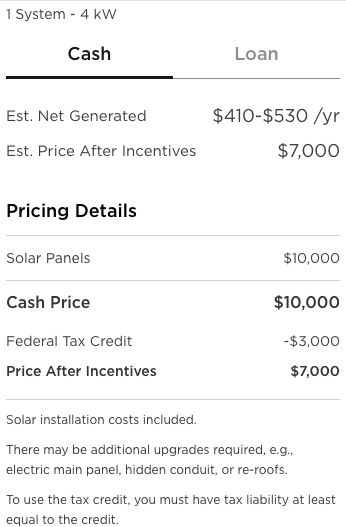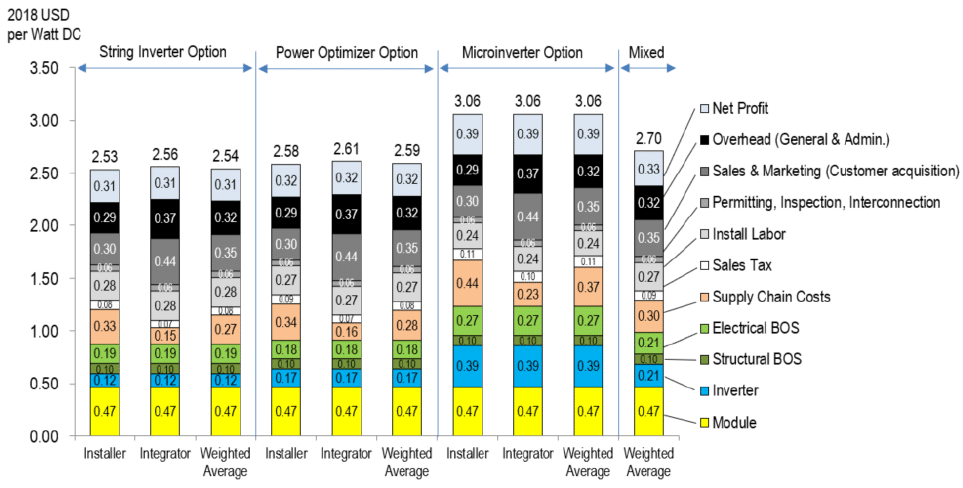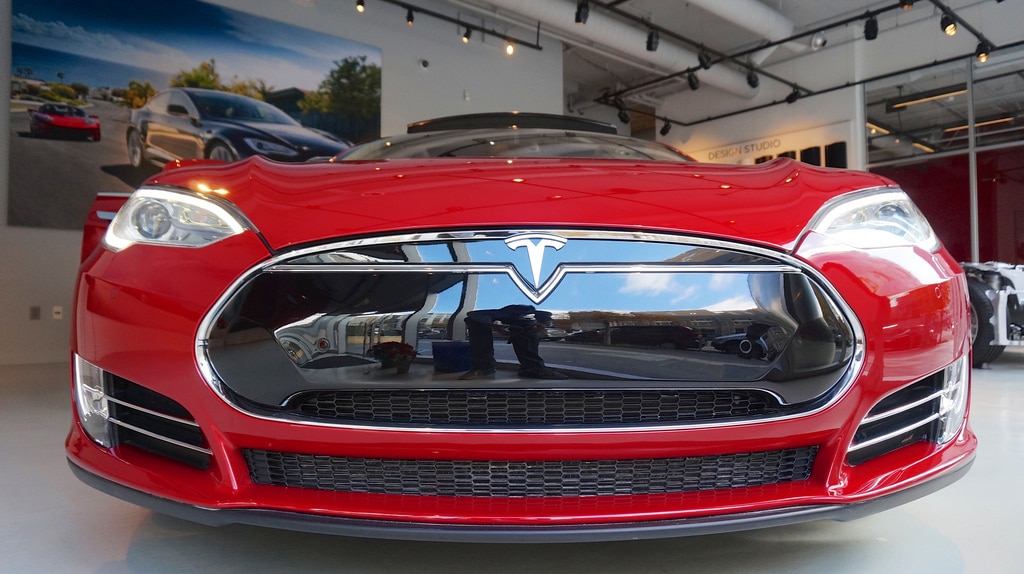One persistent fact of growth of solar as a technology is that it just keeps getting cheaper. Quarter after quarter and year after year the price of installed systems just keeps getting lower, enabling large-scale solar to out-compete conventional generation, and reducing the payoff times for rooftop solar under net metering.
Reductions in PV module costs have driven much of this decline. But soft costs – the non-hardware portions including installation, sales, permitting and overhead – have been much harder to reduce, meaning much slower declines in this segment.
But this doesn’t mean that soft costs can’t be reduced, and sometimes what it takes is a new approach.

Image: Tesla
This week, Tesla’s online sales calculator shows that the company is selling residential PV systems at a cost of $2.85 per watt in California and Massachusetts, and $2.65 per watt in New York, Texas and Florida – the largest markets. Assuming the full 30% federal Investment Tax Credit (ITC) is claimed, this falls to $1.93 and $1.85 per watt.
For at least four states (Colorado, Pennsylvania, Washington and Utah), the price is even lower, at $2.50 per watt and $1.75 per watt if the ITC is fully claimed (see the screen shot at right).
Media outlets are claiming that this is Tesla delivering on its promise to cut residential system costs 16%. We can’t verify this, as this is our first time using the online calculator, and Tesla hasn’t provided average system prices on its quarterly results calls.
However, it is significantly below Tesla’s competitors, with Sunrun reporting $3.17 per watt in the fourth quarter of 2018, and Vivint reporting $3.18 per watt. But Tesla isn’t just undercutting the big third-party solar companies, as its prices are also well below the $2.98 per watt-DC that Wood Mackenzie reported as the average residential solar price in the fourth quarter of 2018, and also below the $3.05 per watt reported by EnergySage as the average on its marketplace in the second half of 2018.
So how – and why – is Tesla doing this?
Strategy shift
In the first half of this decade, growth in residential solar was driven by third-party solar companies, who deployed teams of often-inexperienced sales persons to go door to door and sell solar. This approach, the financing unlocked by the third-party model and an emphasis on growth over profitability allowed SolarCity, Sunrun and Vivint Solar to grow rapidly into the largest national installers.
However, after Telsa bought out SolarCity, things changed. Elon Musk has never shown the interest in rapid growth in solar sales that his cousins Lyndon and Peter Rive did. Musk moved sales off the street and into Tesla stores as well as towards direct sales and away from leases and power purchase agreements.
Along the way cash generation increased, but quarterly sales volumes and market share both fell. Deployment fell further with Tesla closing retail stores and moving sales online, which has reduced Tesla/SolarCity from the largest residential solar company to third- or fourth-largest as of the first quarter of this year.
Customer acquisition elimination
However, along the way Tesla was doing something else: getting rid of the cost of selling solar. While Tesla has never published detailed cost breakdowns, other sources including the U.S. National Renewable Energy Laboratories (NREL) show the cost of selling solar, also termed customer acquisition, as a major component of soft costs.
In fact, NREL’s latest cost breakdown found customer acquisition to be the second-highest cost in the stack, after only modules, at price of $0.35 per watt for the typical system (chart below, gray). This is roughly 13% of total system costs.

Online sales means far fewer salespeople and a minimal cost to acquire customers. This has likely been a factor in Tesla’s improved profitability, and now allows the company reduce costs to below those of its competitors.
Whether or not this will allow Tesla to regain market share is another matter, because this will require consumers to proactively go to its website to get this cheaper solar. But in the long run, with the rise of online solar marketplaces like EnergySage and Pick My Solar, Musk may be beating his competitors to the punch of the next business model.
Update: This article’s lead, body and embedded image were modified at 2:25 PM EST on May 2, to mention that PV systems are available in some states for as little as $2.50 per watt / $1.75 per watt after the ITC, which is lower than the $2.65 / $1.85 figure that we were using earlier.
This content is protected by copyright and may not be reused. If you want to cooperate with us and would like to reuse some of our content, please contact: editors@pv-magazine.com.








Great article, Christian. It’s exciting to see someone attacking soft costs. I just reviewed NREL’s “Solar Ready Buildings Planning Guide”. So much potential for so little cost. It would be interesting to know if an installer offers PV installation for $1.75 per watt for an average home, how much less could the price be if this average home was “Solar Ready” in a predefined and recognized way? Then if permitting was standardized, if not nationally, then by state instead of thousands of “jurisdictions”…..then some more hardware price reductions…. Then we might just be okay post-ITC.
This strategy will work with the model 3. People with an EV are intrested in Solar and they are already on the Tesla website. The only thing holding them back was the price, since local installers where cheaper by a big margin.
With this change i see strong growth in Tesla’s Solar and Energy business.
Great Article, As an installer in Texas that doesn’t manufacture modules. There is very little profit below $2.90 a watt. The best price is $3.05 to 3.17 a watt. This pricing allows a selection of Tier-1 panels (18.9 and above performance) and not Tier-3 low performing panels (15.5 to 16.9).
To Gary;
$1.75 for a standard 5,000 W (16 panels) system would be priced at $8,750.00. The Inverter/Modules/Tax cost would be $8,129.44.
Leaving $621.00 for Permitting/Electrical/Structural/Installation/Supply Chain/Sales-to-Market/Profit
Its really impossible to sale at that price or any below $2.90.
I’m kinda meh now on this news. I bought a system installed last year (Itek panels) from a reputable installer for $2.52/watt before sales tax and ITC rebate. Admittedly scale helped (11.7 kw) and a very simple roofline.
$2 before ITC, that would be impressive.
Consumers can buy a residential solar kit online in the 11kW range with good equipment for about $1.25/watt. Just curious, could you have found a contractor in your area to install and permit it for $.75/watt or about $8k?
Musk/Tesla is a marketing giant with with all eyes on new technology.
Tesla markets cars and power-walls years before they come out and by then he has to change his story because the outcome has changed.
In one way Musk is good about promoting new technology. However most everything he says is already on the market. His smoke and mirrors are telling the public what they want to hear. The truth of the matter is Elon is scooting in on the solar industries coat tails. Musk is big news getting free adverting.
There has been solar roof tiles. There was lithium battery storage going back to 2004. Elon Musk is a great advertising leader. Look around and see it all not just a narrow vision. Those solar prices look pretty good. But. Solar City failed, Tesla Solar failed now internet sales for custom solar for your homes? That has also been done on a large scale and failed. The solar programs in place right now are working. Why fix something that is working just fine and very cost effective.
What the heck it’s only the investors money.